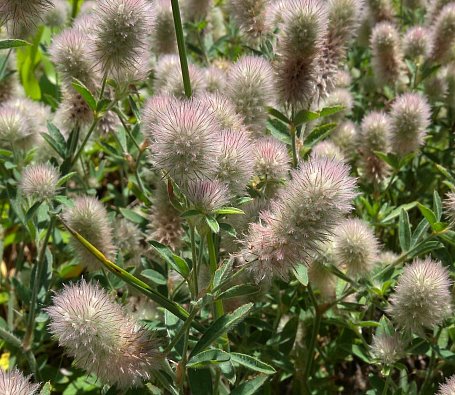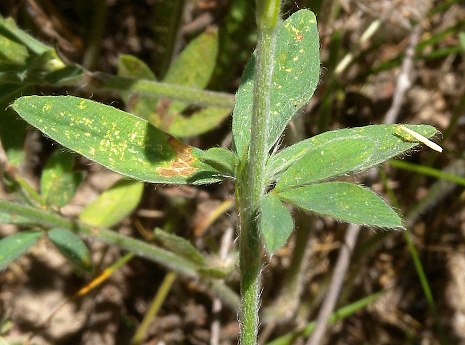
Individual flowerheads about ½-1½" long and ½" across terminate the stems or develop from the axils of the leaves. These flowerheads are pinkish gray with a fuzzy-hairy appearance and they are globoid to short-cylindrical in shape. Each flowerhead has a short peduncle that is similar to the stems. Numerous small flowers are densely arranged along all sides and the entire length of a flowerhead. Each flower is about ¼" in length, consisting of a white corolla with 5 petals, a greenish-red calyx with 5 long bristly teeth, several inserted stamens, and a pistil with a single style. The body of the calyx is short-tubular and hairy, while the teeth are usually reddish with white feathery hairs; these teeth extend beyond the corolla. The narrow corolla consists of a banner (upper petal), a pair of wings (2 lateral petals), and a small keel (2 lower petals); the banner extends beyond the other petals and functions like a hood. The blooming period occurs during the summer and lasts about 2-3 months. The flowers are capable of self-fertilization in the absence of cross-pollination. Afterwards, the flowers are replaced by small seedpods about 1/8" (3 mm.) long; they are partially hidden by the persistent calyx. Each seedpod contains a single seed about 1.0-1.5 mm. in length. This wildflower reproduces by reseeding itself, often forming colonies of plants at favorable sites.
Cultivation: The preference is full sun, dry-mesic conditions, and sandy soil. This wildflower may spread aggressively in sandy disturbed areas.
Range & Habitat: The non-native Rabbit-Foot Clover is occasional in sandy areas of Illinois, otherwise it is rare or absent. This species was introduced from Eurasia. Habitats consist of upland sand prairies, areas along railroads, sandy fields, and waste areas. Relatively open disturbed areas are preferred where competition from other kinds of ground vegetation has been reduced.
Faunal Associations: According to Müller (1873/1883) in Germany, the insect pollinators of the flowers consist of a variety of bees, including honeybees, bumblebees, leaf-cutting bees (Megachile spp.), and Halictid bees. Small butterflies and skippers may visit the flowers to a lesser extent. These insects suck nectar from the flowers. The remaining information about floral-faunal relationships in this section applies primarily to Trifolium spp. (clovers) in general. Many insects feed on the foliage, stem pith, roots, or other parts of clovers. These species include Hypera nigrirostris (Lesser Cloverleaf Weevil), Hypera punctata (Cloverleaf Weevil), Sitona hispidulus (Clover Root Weevil), Languria mozardi (Clover Stem Borer), Nearctaphis bakeri (Clover Aphid) and other aphids, Philaenus spumaria (Meadow Spittlebug), Agalliota sanguinolenta (Clover Leafhopper), Agalliota quadripunctatus (Four-Spotted Leafhopper), Sericothrips cingulatus (thrips sp.), Melanoplus sanguinipes (Migratory Grasshopper) and other grasshoppers, caterpillars of Caenurgina crassiuscula (Clover Looper Moth) and other moths. In addition, the caterpillars of some butterflies and skippers feed on clovers, including Colias eurytheme (Orange Sulfur), Colias philodice (Clouded Sulfur), Everes comyntas (Eastern Tailed Blue), and Thorybes pylades (Northern Cloudywing). The Insect Table has a more complete list of insect feeders. Some vertebrate animals also use clovers as a source of food. For example, such upland gamebirds as the Greater Prairie Chicken and Wild Turkey feed on the foliage and seeds, while such songbirds as the Mourning Dove, Horned Lark, and Chipping Sparrow feed on the seeds only. The foliage is also eaten by some mammals: these species include rabbits, groundhogs, deer, horses, cattle, and sheep. Because the flowerheads of Rabbit-Foot Clover are exceptionally hairy, their consumption can damage the health of horses and domestic livestock by causing abdominal obstruction. In open sandy areas, the Plains Pocket Gopher feeds on the foliage and roots of clovers. Similarly, the Thirteen-Lined Ground Squirrel eats their seedpods.

Photographic Location: An upland sand prairie at the Indiana Dunes National Lakeshore in NW Indiana.
Comments: Rabbit-Foot Clover is easy to distinguish from other plants because of its exceptionally hairy flowerheads and trifoliate leaves. No other clover species (Trifolium sp.) in Illinois has such hairy flowerheads. It is rather unfortunate that Rabbit-Foot Clover is not native to North America, even though it is somewhat weedy, because its flowerheads are quite cute and appealing.